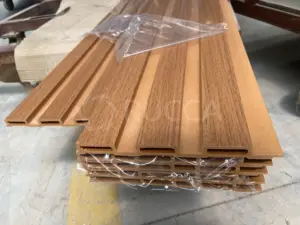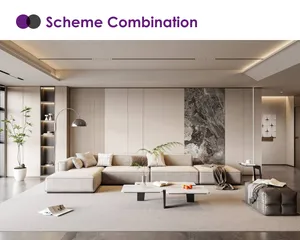Introduction
In the realm of modern architecture, exterior wall panels play a pivotal role in defining the aesthetics and durability of a building. These panels, made from a variety of materials, serve as the first line of defense against the elements, significantly influencing a building's overall protection. From classic brick to innovative composites, each type of panel brings unique visual appeal and performance characteristics. This article delves into the world of exterior wall panels, exploring their types, aesthetic appeal, durability, and maintenance. It also provides insights into choosing the right panels for modern homes, considering factors like longevity, ease of installation, and sustainability.
Understanding Exterior Wall Panels
Exterior wall cladding, or panels, are a vital component in construction, offering protection against the elements and contributing to a building's durability. The material chosen for these panels depends on the project scope, preferences, and climate. Common materials include metal, wood, brick and mortar, and vinyl. The effectiveness of these panels also relies on the layers beneath, such as flashing, insulation, vapor barriers, and weather membranes. Thus, exterior wall panels serve as the first line of defense, significantly influencing the overall protection of a building.
Types of Exterior Wall Panels
Exterior wall panels come in various materials, each with unique aesthetics and durability. Brick, a classic choice, offers warmth and strength but lacks design variations. Vinyl is affordable and versatile but vulnerable to sun damage. Wood panels add rich character but require high maintenance. Composite panels offer unique styles and better durability but carry safety risks. Stone panels, like limestone and marble, offer longevity but are costly. Fiber cement combines beauty, strength, and affordability. Aluminum is affordable and fire-resistant but can dent easily. Steel is strong and long-lasting but heavy and prone to rust. Lastly, stucco is energy-efficient and distinct but requires professional application.
Metal Panels
Metal wall panels offer versatility and design flexibility. Panels made from 100% recycled aluminum are customizable in size, depth, and color, allowing for unique façade designs. They require no sealants, ensuring a clean look and easy installation. Other metal panels, available in steel or aluminum, feature multiple profiles and rib patterns, accommodating expansion and contraction. These panels can be installed both horizontally and vertically, adding visual intensity to a building’s exterior.
Wood Panels
Wood panels are a popular choice for exterior wall paneling due to their natural aesthetic appeal and versatility. A variety of wood panels, including adjustable wood slat wall panel kits, are available. These kits come in different sizes and wood types, such as walnut and birch. They are designed to be durable and resistant to various elements, making them suitable for exterior use. Some wood panels also feature decorative fretwork, adding an extra layer of visual interest. Prices vary, making it possible to find options that fit different budget ranges.
Composite Panels
Composite panels are a popular choice for exterior wall cladding. Made from reclaimed wood fibre and recycled plastic, they provide an additional protective layer to your home or commercial building. These panels are impervious to moisture, debris, and extreme weather elements, thanks to the low VOC binders used in their manufacturing. Composite cladding is low maintenance, versatile, easy to install, and eco-friendly. It offers excellent thermal insulation, durability, and additional protection for exterior walls. Despite a higher initial cost and potential for slight fading over time, its benefits make it a worthwhile investment.
Stone and Brick Panels
Stone and Brick Panels are a popular choice for exterior wall panels due to their aesthetic appeal and durability. A variety of faux stone siding panels are available. These panels mimic the look of natural stone and brick, providing a sophisticated touch to any exterior. They come in various styles, such as Stacked Stone, Ledger Stone, and Stone Wall, and a range of colors from earthy browns and grays to vibrant reds and blues. The panels also vary in size, allowing for customization based on your specific needs. Notably, some brands offer fire-rated options for added safety.
The Aesthetic Appeal of Exterior Wall Panels
Exterior wall panels, such as outdoor WPC fluted wall panels, not only provide impressive exterior looks but also offer a variety of wood colors to choose from. These panels are resistant to weather and scratching, enhancing their aesthetic appeal. Decorative fence panels are another option that people use to make their yards aesthetically pleasing. Even options like outdoor tiles can be mounted directly on the wall to create a unique aesthetic. Lastly, privacy screens can add an element of style while providing privacy.
Durability and Maintenance of Exterior Wall Panels
Exterior wall panels are exposed to natural forces like rain, heat, and cold, leading to inevitable deterioration over time. The key to maintaining these panels is identifying and repairing problems before they become serious. Water infiltration is a common cause of wall failure, leading to structural damage. Poor design, improper materials, and superficial fixes can exacerbate deterioration. Regular inspections can detect minor issues before they escalate into severe, costly problems. Routine upkeep and preventive maintenance are crucial in promoting the longevity of a building, improving performance, and keeping the exterior looking fresh and attractive.
Choosing the Right Exterior Wall Panels for Modern Homes
When choosing exterior wall panels for modern homes, consider durability, ease of installation, code compliance, longevity, warranty, and sustainability. Phenolic cladding panels offer excellent durability, including impact, scratch, graffiti, wind, and UV resistance. They also provide ease of installation with different methods and orientations. These panels comply with local and national codes, have a lifespan of 40-60 years, and come with a limited warranty. Moreover, they are a sustainable choice, reducing the environmental impact.
Conclusion
Exterior wall panels are a crucial aspect of modern construction, combining aesthetics and durability. They come in a variety of materials, each offering unique benefits and drawbacks. Whether it's the design flexibility of metal panels, the natural charm of wood, the eco-friendliness of composites, or the sophistication of stone and brick, the choice depends on individual preferences, project scope, and climate. Regular maintenance and inspections are key to ensuring their longevity. When choosing panels for modern homes, it's essential to consider factors like durability, installation ease, code compliance, warranty, and sustainability. Ultimately, the right exterior wall panels can enhance a building's aesthetic appeal while ensuring its resilience against the elements.










































 浙公网安备 33010002000092号
浙公网安备 33010002000092号 浙B2-20120091-4
浙B2-20120091-4